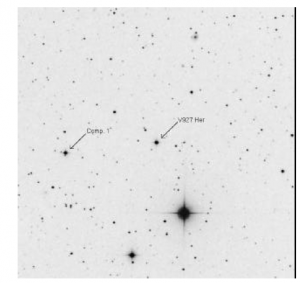Matthew B. Garvin with Dr. Eric Hintz, Physics and Astronomy
Overview
During the course of this summer, I observed a possible ã Doradus/ä Scuti variable star, V927 Herculis. Observations of this star were made using the David Derrick 16 inch telescope located on the Brigham Young University (BYU) campus in the Orson Pratt Observatory. Due to the often inclement weather, five nights of time-series photometry data were obtained. The data were compared to the known characteristics of the ä Scuti and ã Doradus class of variable stars. V927 Herculis was found to have characteristics similar to both classes. Spectroscopic data need to be obtained to make a clear distinction of which of these two variable star classes it most resembles.
Background
BYU has a strong reputation in pulsating variable star research. Of the many classes of pulsating variable stars, the ä Scuti and recently the ã Doradus class are of the most interest. Variables stars are grouped into classes by comparing several physical attributes of the star, for example, the spectral type, the period and amplitude of pulsation, the type of pulsation, and metallicity. The period is the most readily obtained information about a variable star using time series photometry. ã Doradus stars typically have periods ranging from 0.4 and 3 days, with the average about 0.8 days (1). The period of pulsation for ä Scuti stars are typically around 0.2 days. The amplitudes of pulsation, or the change in apparent magnitutdes, of ä Scuti and ã Doradus are similar. ä Scuti stars have a wider range of amplitudes from as high as 0.2 down to 0.05. ã Doradus stars are typically lower amplitude stars which correspond to the lower range of the ä Scuti stars. Low amplitude ä Scuti stars and ã Doradus stars have G-mode pulsation, meaning their pulsation occurs below the convective layer of the star. This raises many questions. Are ã Doradus stars merely low amplitude ä Scuti stars? What characteristics allow us to make a sharp distiction between ä Scutis and ã Doradus stars?
My project involves collecting data on stars that have periods and amplitudes that place them in question as to whether they are ã Doradus or ä Scuti stars. The star I observed this summer is a new variable star found by the Hipparchos satellite. No data on this star has been published previous to the Hipparchos catalog.
Observations
The data were taken using a Mead 416 and a Mead 1616 CCD camera. Each night about one to two hundred frames were taken at 50 seconds per exposure. The data were reduced using IRAFBImage Reduction and Analysis Facility.
Below is picture of the field of V927 Herculis.
In the figure the positions of V927 Herculis and the comparison star used for the differential solution are marked.
In each frame taken by the CCD, the apparent magnitudes of the object and its companion stars are calculated. These data are then compared to one another to create a differential solution. During the course of a night, the atmosphere is constantly changing. If the raw apparent magnitudes were used alone, the graph would look like noise due to the changing atmosphere. By using a statistical comparison between star and object, the atmospheric noise can be subtracted revealing the light curve of the variable star. This process assumes that the atmospheric conditions remain constant over a very small area. The amount of sky shown in figure 1 is minuscule compared to the sky visible in a night, thus this assumption is reasonable.
Analysis
Several key features of V927 Herculis are seen readily from the data taken this summer. First, the apparent magnitude at maximum light modulates. Second, the apparent magnitude at minimum stays the same. This behavior is considered a characteristic of ã Doradus stars. Interestingly enough, the star ã Doradus itself has this behavior. Using a period analysis program, the principle period of V927 Herculis was found to be 0.13 days. This is a period common to the ä Scuti class of variable. The principle amplitude was found to be about 0.05, which is common to both ä Scuti and ã Doradus stars. These results are interesting. They suggest that there does not exist a clear division between ã Doradus and low amplitude ä Scuti variable stars. These results are not enough, however, to confirm this. Spectroscopic data are needed to make a clearer distinction. From spectroscopic data, the mechanism by which the star pulsates could be determined, as well as age, and mass. Fourier analysis of the data obtained this summer could also lead to some new insights.

References
- Kay et al. 1999, PASP,111,840-844
